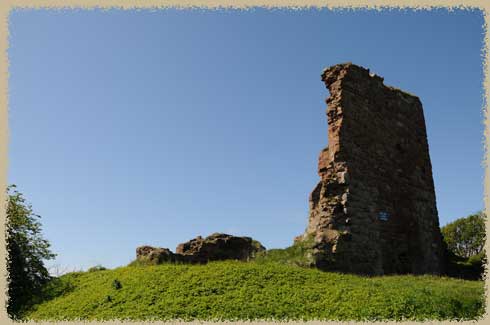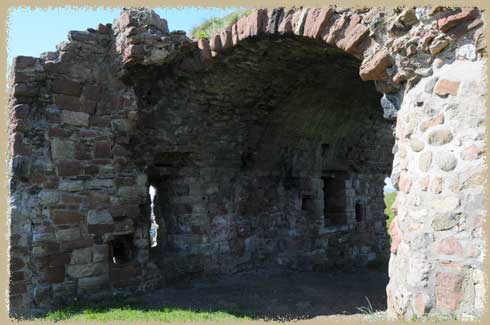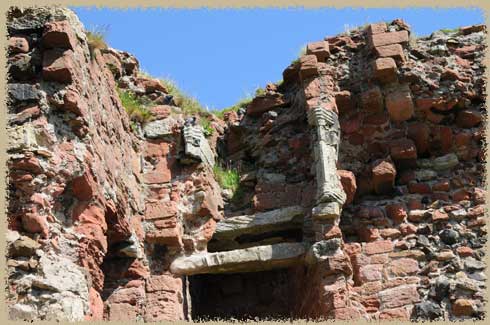Ardrossan Castle
Ardrossan was a thriving port inthe 18th and 19th centuries, with trade in coal and pig iron supprting a strong shipbuilding industry. The shipyards were mostly gone by the 1950s, the last closed in the 1980s. The town is known now more for its tourist attractions and seaside location.

one of the piecesof ardrossan, probably a vaulted cellar
With a moat!
While the castle really did had a moat, not much remains of it, just the castle sitting on a bluff over the harbor. Only a few remnantsof the castle still stand -- a low stub of a building with a vauted basement, and the tower, at least up to the top floor. The vaults are nicknamed 'Wallace's Larder', after a battle in which the English garrison here was slaughtered, during the wars of independence. It would have been a strong castle--the sparse remains here are testament to that.
The current ruins, of coruse, are not the original castle here. The high ground was a desirable site. The earlier castle of 'Cannon Hill" was built c1140 by Simon de Morville. The castle passed to the Barclay family around 1226, when the current owner died without an heir.

only one wall and part of a corner remain of the original keep
The castle was rebuilt in the 15th century by the Montgomery family. The rebuilding is fairly obvious -- reddish sandstone instead of the paler original limestone was used. Montgomery's son became the first Earl of Eglinton, and the family stayed in the castle wihen their family castle was destroyed.
Ardrossan, like many other castles, was demolished by Cromwell in 1648. They dismantled the castle and used the stone to build a fort in Ayr, and the Earl of Eglinton continued quarrying stone from the castle in the mid-18th century to build the walls of a local park
Wallace's Larder
In 1292, the castle was taken by the English under Edwrad I -- but it was retaken by Wiliam Wallace in 1296. He set a fire inthe nearby village to draw out the English soldiers, and picked them off one by one as they crossed the moat. When it was over, Wallace tossed the dead and survivors alike into the vaulted basement of the tower (along with the supplies) and left them to rot. The castle was dismantled around them.
Salter refers to the cellars as "the Vallance Lardner" -- medieval spelling was a bit iffy, apparently.

the vaulted cellars known as Wallace's Larder
Hazardous Ruins
The ruin of the castle is considered dangerous -- small signs warn you not to climb on the stones, but the trash and bottles littering the site is evidence enough that the locals kids party up here fairly frequently. Be careful, though - things have been shored up and consolidated at some point, but the ground is uneven, and the rooms in the tower are shaky, at best. The local council performed work on the castle in 1911 and it has been only minimally maintained since.
There are two main parts of the csatle - the keep rises to three stories (at least on one side, the rest of the tower has fallen. It does leave the remains of fireplaces and interior decoration exposed, so that's a plus. The other part is the infamous south range containing the vaults of Wallace's Larder, with are the high vaults of the bsaement and kitchen range of the castle.

The courtyard would have been enclosed by thick walls, and is protected by steep cliffs on the seaward side, and a ditch (moat) on the flat land toward the park. Stone foundations remain on all four sides of the original courtyard, but mostly they are just a few scattered stones under the grass, Amazingly, some of the details do remain in the tower -- the carved mantel of a second-story fireplace, a pointed

